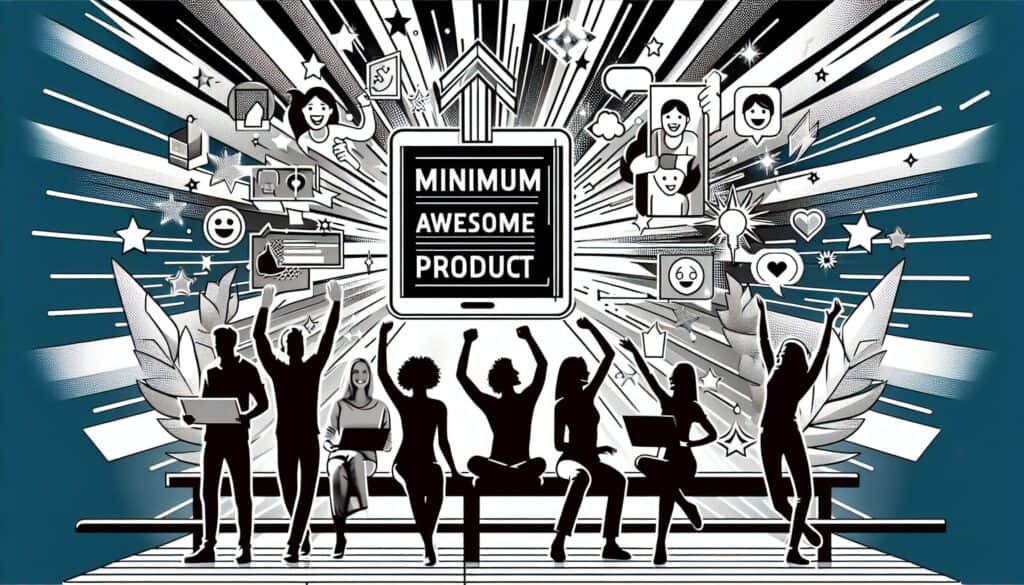To create the smallest possible product that users will find not just viable or marketable, but genuinely impressive and delightful, focusing on a high-quality user experience for its core features.
- Methodologies: Customers & Marketing, Economics, Product Design
Minimum Awesome Product (MAP)

Minimum Awesome Product (MAP)
- Agile Methodology, Customer Experience, Innovation, Minimum Marketable Product (MMP), Minimum Viable Product (MVP), Product Design, Product Development, User experience (UX), User-Centered Design
Objective:
How it’s used:
- Teams focus on delivering a polished and highly satisfying experience for a limited set of features, aiming to generate strong positive emotional responses and early evangelists.
Pros
- Creates strong initial user engagement and loyalty, generates positive word-of-mouth, sets a high-quality standard from the start.
Cons
- Can take longer and be more expensive to develop than an MVP, 'awesome' can be subjective and hard to define, may delay market entry.
Categories:
- Customers & Marketing, Ideation, Product Design
Best for:
- Creating a strong positive first impression and generating early brand advocates by delivering a high-quality, delightful experience with a focused feature set.
The Minimum Awesome Product (MAP) methodology finds applications in various sectors like technology start-ups, consumer electronics, and e-commerce, where rapid market entry is vital to capture user interest. Typically, it is employed during the initial phases of product development when teams prioritize a select set of features that can provide significant value and delight users. This approach often benefits from collaboration among cross-functional teams that include product managers, designers, engineers, and marketing professionals who contribute to crafting a compelling user experience. The MAP strategy can be particularly effective in industries characterized by high competition and fast-paced innovation cycles, such as mobile app development or wearable technology, where first impressions significantly impact user adoption rates. Initiatives may be sparked by innovative entrepreneurs or established companies looking to launch new products, generating excitement through well-executed marketing campaigns that highlight the unique aspects of the offering. The emphasis on creating a polished experience with minimal features encourages teams to innovate within constraints, leading to the development of strong user loyalty and community support as early users share their experiences, further enhancing the product’s visibility in crowded marketplaces. This approach is increasingly recognized for its ability to set a high bar regarding quality and user engagement from the outset, establishing a foundation for scalable growth as additional features are integrated based on user feedback and evolving market demands.
Key steps of this methodology
- Identify and define the core problem to solve.
- Select a narrow feature set that addresses the core problem.
- Develop high-fidelity prototypes that deliver exceptional user experience.
- Conduct iterative testing focused on user reactions and emotional responses.
- Refine the product through continuous feedback and improvement.
- Launch the product to a targeted audience for initial engagement.
- Create marketing strategies to enhance user delight and advocacy.
Pro Tips
- Conduct in-depth user research to identify pain points and prioritize features that deliver significant emotional impact.
- Iterate rapidly with user feedback cycles to enhance the delight factor of the minimum feature set while maintaining quality.
- Leverage storytelling techniques in your design to create a narrative that resonates emotionally, turning users into advocates.
To read and compare several methodologies, we recommend the
> Extensive Methodologies Repository <
together with the 400+ other methodologies.
Your comments on this methodology or additional info are welcome on the comment section below ↓ , so as any engineering-related ideas or links.
Historical Context
1949
1950
1950
1960
1960
1960
1960
1940
1950
1950
1958
1960
1960
1960
1960
(if date is unknown or not relevant, e.g. "fluid mechanics", a rounded estimation of its notable emergence is provided)















Related Posts
METS to Calories Calculator
Meta-Analysis
Message Mapping
Mental Model Diagrams
Maximum Acceptable Pushing and Pulling Forces
Material Requirements Planning (MRP)